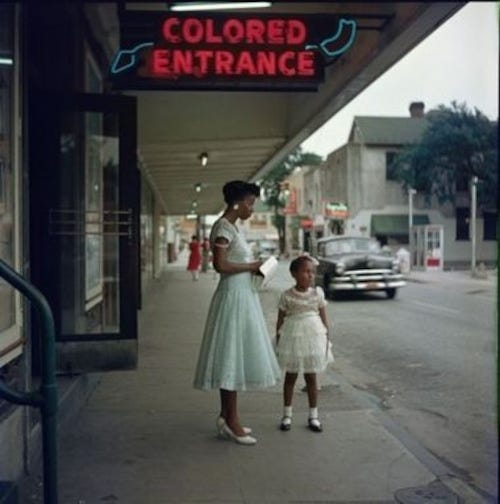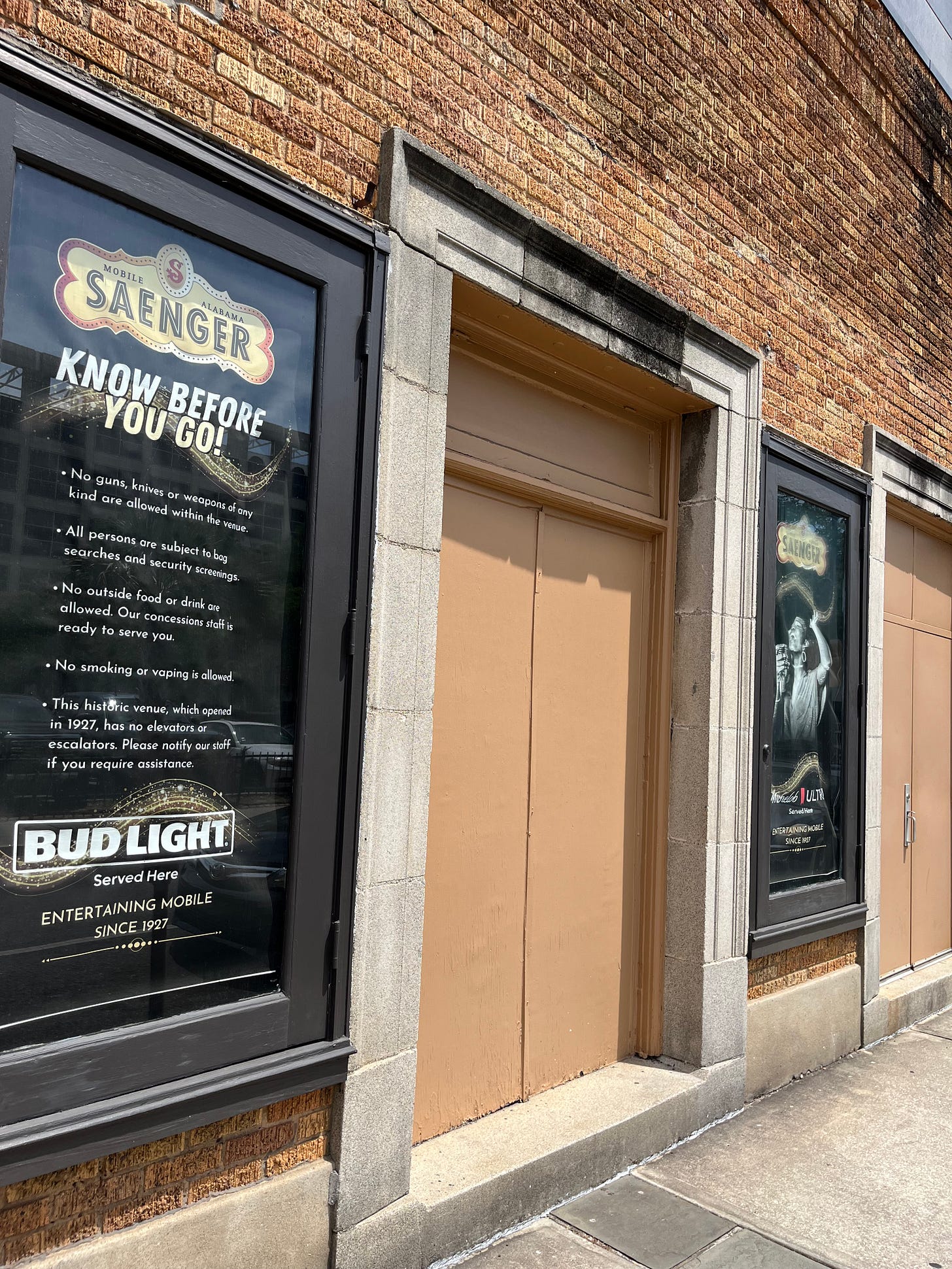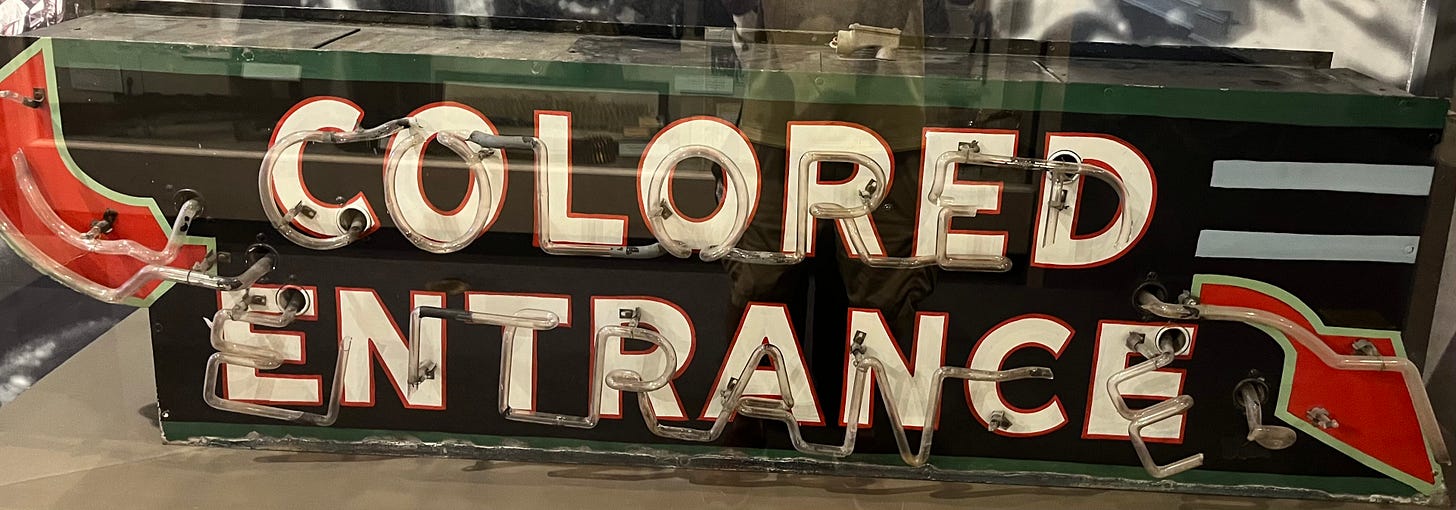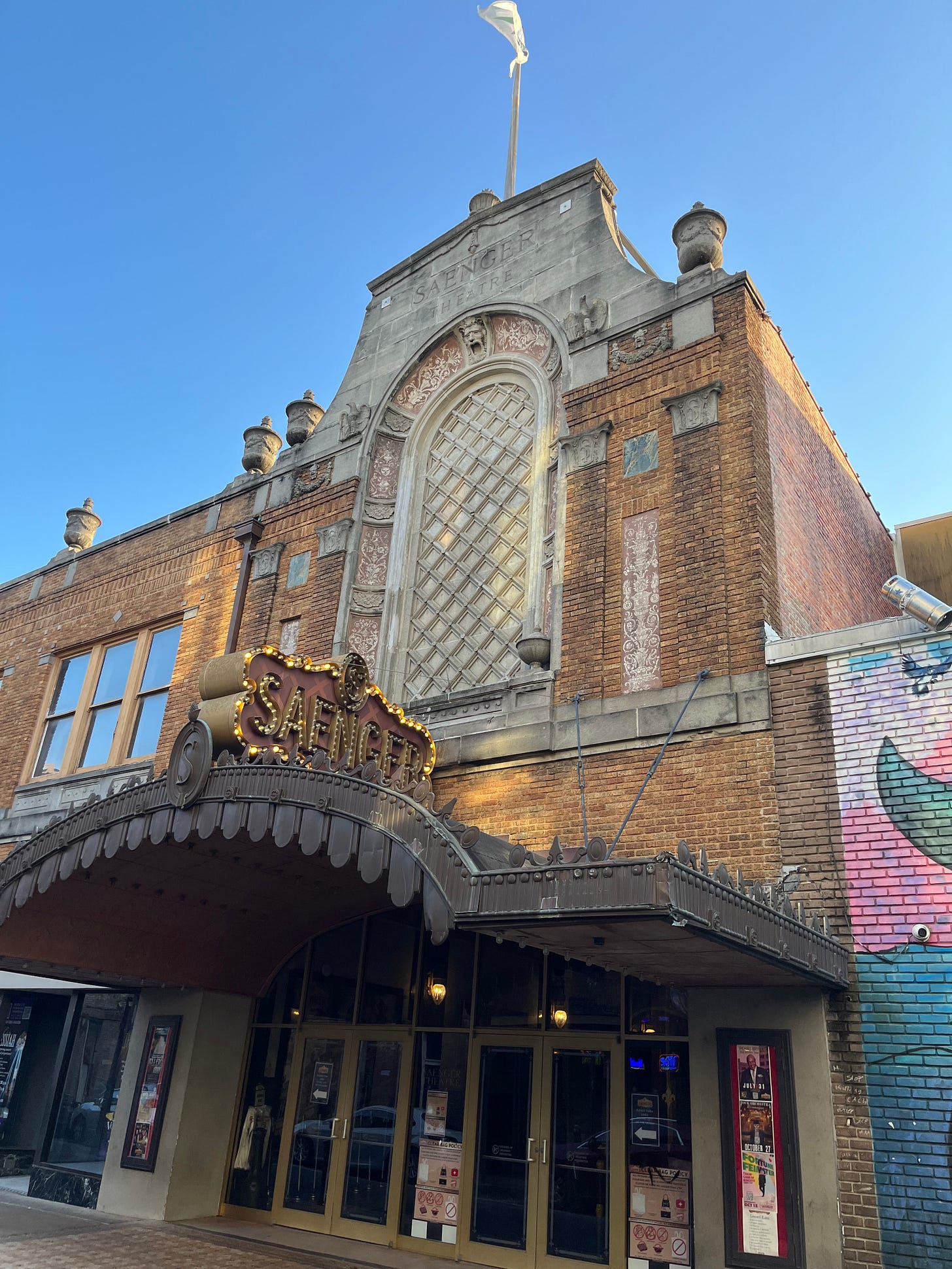Finding history in 1956 Mobile, Alabama
You have to wonder what Elise Stefanik thinks as she passes all those protesters
Please consider supporting The Front Page with a paid subscription: HERE
It was one of those old neon signs with glowing red letters. It previously lit part of Conti Street in downtown Mobile, Alabama.
It was now under glass in the History Museum of Mobile a few blocks from where it once hung outside the Saenger Theater as testimony to another time in the South's history. The sign was immortalized when a young Black photographer named Gordon Parks snapped an image of an impeccably dressed young Black woman and her niece one day in 1956.
The year was 1956 and I stumbled onto the photo a couple years ago while doing research on Mobile and trying to understand what the city was like when a Navy sailor and his Irish bride - my parents - said their vows a few blocks away in the big Catholic church on South Claiborne Street.
Years later, their only grandson found their marriage license on a page labeled "white marriage licenses" in the state of Alabama records and we were again reminded of the world they inhabited as they started their lives together.
The possibility that the paths of my parents and Gordon Parks intersected in the small downtown area that summer were hard for me to ignore.
Over the past few days in Mobile, I had been rewarded with the paperwork from my parents' marriage, a visit to the church where the ceremony occurred while also finding the site where a young sailor in his dress blues once had his photo taken in front of the large fountain in Bienville Square. Two years later, that sailor revisited the Square to buy an engagement ring at Leon's Jewelers.
There was a flood of emotions in just a few hours.
But as I walked back from the museum with that neon sign image still planted in my brain, as I passed a street I could see the marquee of the Saenger Theater.
I turned around.
The Saenger Theater is one of those wonderful old vaudeville houses that opened in 1927 seating over 2,000 for shows. It was part of a chain of some 300 theaters across the South.
High above the marquee "Saenger Theater" is engraved in the cement with carved eagles and Gargoyle-like heads meant to resemble a European opera house. It is an impressive building even today.
By 1950, the theater was showing movies and knowing my mother's love of cinema, I can imagine her making her way to the downtown theater while waiting for my father's ship to make port, and maybe, just maybe one day as she waited for the matinee she stumbled on a young black man taking a photo and asking him "What does that mean?" while pointing at the glowing red neon sign around the corner from the main entrance.

"Colored Entrance" would have had no significance for my Irish mother, but of course that is just in my imagination.
The photo depicts Joanne Thornton Wilson and her niece Shirley Anne Kirksey standing in front of the Black entrance for the Saenger Theater, perfectly attired in elegant, frilly dresses.
Above them, is the sign that is now in the museum up the street.
The photo was part of a series of photos that Parks took for a story on "segregation" in the South that was published Life magazine on Sept. 24, 1956. Oddly, despite its subtlety, the photo never ran in Life.
Determined to find the spot where the photo was taken, I walked up and down the street in front of the theater, but nothing matched. Everything was different from 69 years ago.
That night, I returned to the photo and compared it with the photos I took of the building earlier. Gradually, 1956 began came into focus.

The photo was actually taken on the side of the building on Conti Street and not the front. The railing in the original photo was still there and so were double doors that are no longer used.
It was beginning to make sense.
I suspected the "Colored entrance" would be on the side and would lead to the balcony upstairs where Blacks were kept separate.
The Saenger Theatre administrative offices were just feet away and I asked a receptionist if she knew anything about the famous photo. She did not.
There was a staircase behind her and I wondered if that went to the balcony. The theater's director came out and told me she knew about the famous photo and confirmed the doors outside led to a staircase to the balcony.
I had found the spot.
The Gordon Parks Foundation now exists to celebrate and preserve his work. In 2014, Maurice Berger published an essay "With a Small camera tucked in my pocket" about Parks. It included this:
Preeminently, he set out to challenge the myths of difference and aberrance that underwrote racism—misbeliefs that allowed one group to declare its superiority over another by capriciously ascribing to it negative traits, abnormalities, and pathologies. Nowhere is this challenge more effective than in Parks’s photograph of Joanne Wilson, a stunning image that never made it into the final publication. The two are pictured on a balmy summer afternoon standing in front of a movie theater in downtown Mobile, dressed in their Sunday best. The neon sign that looms overhead—“Colored Entrance”— casts a despairing shadow, transforming a relatively mundane scene into a powerful social commentary.
Wilson was honored by the Gordon Parks Foundation in 2013 for her role in the historic project. She passed away in August 2014 after teaching for 30 years at Blount High School just a few miles from where the famous photograph was taken. Shortly after that, her son Michael Wilson and her granddaughter Mycah Wilson visited the Saenger Theater and the spot of the historic photo.
"My mother always dressed up," Michael Wilson told AL.com. "That was just part of her. And if you were going somewhere with her, you were going to be dressed nicely."
In November, 2014, Parks' photos were part of an exhibition at the High Museum in Atlanta.
Eleven years earlier, Michael and Mycah Wilson also searched for the spot of the photo, finding the sealed doorway, the handrail in the original photo and a patched place on the brick wall where the awning, now gone, was once attached holding the sign over Joanne Wilson's head.
When they were let inside, they found the distinctive pattern of three horizontal bars on the inside door and a little ticket window that once served the patrons to the colored entrance.
"A lot of people from my generation are so impressed by the poise my grandmother had in that photo, despite the irony" Mycah Wilson told AL.com. "It brings a lot of pride. That means a lot because people can think that it was so long ago, and we need to remember the strength of people who had to endure that era."
Michael Wilson concurred that his mother was sending a message, "I don't have to look like I'm enduring this," he told AL.com.
“I always wanted to look neat and nice,” Joanne Wilson said years earlier. “I did not want to be mistaken for a servant. Dressing well made me feel first class. I wanted to set an example.”
Today, everyone enters the theater through the grand lobby on Joachim Street. The doors on Conti Street are no longer used.
In 2013, Maurice Burger wrote in his essay:
When Ms. Wilson stepped out to enjoy an afternoon with her niece, she stepped into history through a single, brilliant photograph. What we see in Parks’s image is a determined and self-possessed woman, defying stereotypes and steeling herself against the poisonous tide of oppression that threatened to engulf her and her family. Her humanity under assault, she chose—in her own way—to fight back. In so doing, she helped change the world.
And on this day in Mobile, Alabama, I needed to see where that happened.

Welcome back Elise
Some 200 constituents greeted Rep. Elise Stefanik in Halfmoon Wednesday where she was scheduled to speak at a $350 a plate Republican fundraiser.
You can't help but wonder what she thinks when she whizzes by the growing number of protesters.
Does she think they are all just opposition Democrats?
Does she believe she is on the right side of history by spreading lies and endorsing unconstitutional policies?
The Albany Times Union reported the protest was organized by the organization Indivisible because of Stefanik's failure to hold town hall meetings.
But she was available for a fundraiser that is not even in her district.
The Republicans honored Capital District developer and prolific campaign contributor Bruce Tanski as the Saratoga County Republican of the Year.
The T-U reported that "the developer had been tangled up in several investigations and legal battles over the last decade. In 2014, he pleaded guilty to a misdemeanor in Saratoga County Court, settling legal charges that he had used six accomplices to conceal political donations to former Halfmoon Supervisor Melinda A. Wormuth. An FBI probe also scrutinized a $50,000 payment that Tanski made to Wormuth — who later served time in prison for taking cash bribes while in office — but he was not charged in connection to that loan."
The T-U also reported:
In 2020, Tanski’s former longtime business partner, Peter D. Amato, was sentenced to a year’s probation for submitting fraudulent loan application charges. Tanski’s construction company built the residential projects at the center of the alleged bank fraud. Although he had been identified as a co-conspirator in the case, he was never charged or accused of wrongdoing before the U.S. Justice Department dropped the case.
That's Saratoga County's Republican of the Year.
Quote of the Day
While covering May Day protests all over the country, this quote in the New York Times really stood out:
"We seem to be facing the destruction of the United States,” said Jason Stanley, a Yale professor and an expert on fascism. “I don’t see anyone articulating that this is an attack on what it means to be American, on the very idea of America, and it’s an emergency.”
On the road
Retired Post-Star sports editor Greg Brownell is off seeing America again.
If you are old enough to remember Charles Kuralt's "On the road" segments with CBS news, you might want to check out his new Substack column that will cover his month-long trip as he crosses the country to tell the stories of America, much like Kuralt did in the 1980s and 90s.
We're hoping Greg will contribute an occasional guest essay over the next month. Sign up for his Substack column today. It is free.
Correction
In Friday's column about how much medicaid aid would be cut to the 21st Congressional District, I referred to it as "Medicare" instead of "Medicaid." I tend to do that frequently.
Thanks to the readers who spotted it.
Ken Tingley spent more than four decades working in small community newspapers in upstate New York. Since retirement in 2020 he has written three books and is currently adapting his second book "The Last American Newspaper" into a play. He currently lives in Queensbury, N.Y.








“You gain strength, courage and confidence by every experience in which you really stop to look fear in the face. You are able to say to yourself, 'I have lived through this horror. I can take the next thing that comes along.' You must do the thing you think you cannot do.” - Eleanor Roosevelt
Get up, stand up!
Dressing to go anywhere was part of the social contract in the 50s and 60s. I am white, I grew up in Queens and I remember that you didn’t go to any social engagement without looking your best.
As a child, this made me feel really special. Getting dressed for the movies was like getting to be a little adult. Your article reminds me that this experience was marred by people who did everything they could to make people of color feel like they were less than.
I appreciate the poise which that woman and child approached such hatred and wonder if I could’ve been so self-possessed in a similar situation.